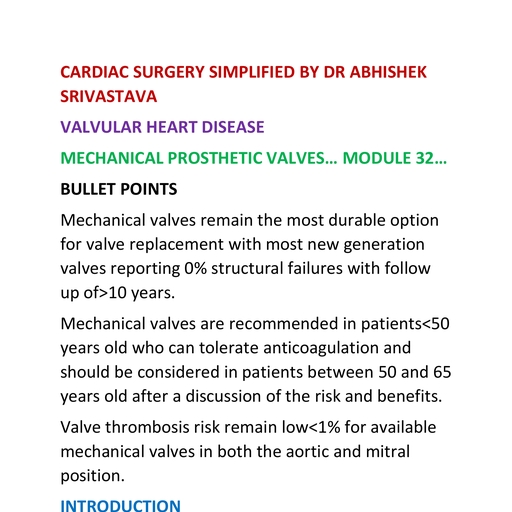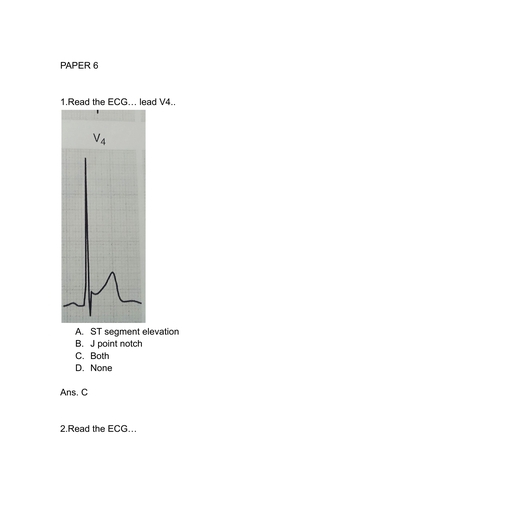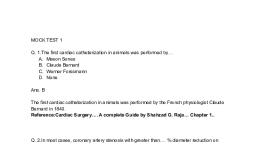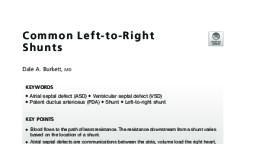Page 1 : oe MITER IS CULUS Ca), , , , €) Basic wrormation, , DEFINITION, , Mitral stenosis is a narrowing of the mitral valve, orifice that prevents proper opening during, diastole and obstruction of blood flow from the, left atrium to the left ventricle. Due to thickening, of the leaflets there is restricted movement. The, obstruction leads to increased pressure in the, left atrium, pulmonary vasculature, and the right, side of the heart. The cross section of a normal, orifice measures 4 to 6 cm2. Symptoms usually, develop with exercise when the orifice mea‘sures <2.5 cm?, and symptoms may develop at, rest when the orifice is <1.5 cm?, , SYNONYM, Ms, , ICD-10CM CODES, , 105.0 Rheumatic mitral stenosis, , 105.2 Rheumatic mitral stenosis with, insufficiency, , 134.2 Nonrheumatic mitral (valve) stenosis, , Q23.2 Congenital mitral stenosis, , EPIDEMIOLOGY &, DEMOGRAPHICS, , © The predominant cause of mitral stenosis is, rheumatic heart disease; however, the occurrence of mitral valve stenosis has decreased, worldwide over the past 30 yr (particularly in, developed countries) as a result of declining, incidence of rheumatic fever due to appropriate antibiotic use., , Rheumatic heart disease has a predilection, for the mitral valve, aortic valve, and to some, extent the tricuspid valve., , The incidence of MS is higher in women (2:1, female-to-male ratio)., , There is high prevalence of rheumatic heart, disease in developing countries., , TABLE 1 Stages of Mitral Stenosis, , © Outbreaks of rheumatic fever in the U.S. are, due to increased virulence of a streptococcal, strain or enhanced immigration from where, rheumatic heart disease is prevalent., , PHYSICAL FINDINGS & CLINICAL, PRESENTATION, , Dyspnea is the most common symptom,, along with fatigue and decreased exercise, capacity. These symptoms occur due to an, inability to increase cardiac output, especially, with exercise, and elevated pulmonary capillary wedge pressures, with resultant increase, in pulmonary artery pressures. Stages of, mitral stenosis are summarized in Table 1., “Mitral facies” that are pinkish-purple patches on the cheek due to low cardiac output, and vasoconstriction, usually indicate severe, , Paroxysmal nocturnal dyspnea (PND) and, orthopnea secondary to elevated left atrial, pressure may occur., , Acute pulmonary edema may occur after, an increase in flow across the mitral valve, secondary to an increase in cardiac output or, heart rate (exertion, tachyarrhythmias, fever,, anemia, etc.)., , Pulmonary hypertension that results from, chronically elevated pulmonary capillary, wedge pressures can lead to right ventricular, (RV) dysfunction and signs and symptoms of, right heart failure (hepatomegaly, pulsatile, liver, peripheral edema, ascites)., , The left ventricle is typically “protected” in, mitral stenosis and exists in a low-pressure, state; however, MS often coexists with mitral, regurgitation and occasionally with aortic, valve dysfunction, both of which can cause, left ventricular dysfunction., , Hemoptysis can be present secondary to rupture of thin-walled dilated bronchial veins due, to an abrupt increase in left atrial pressure., Systemic embolic events are caused by left, atrial thrombi. These are associated with, , atrial fibrillation 80% of the time, since mitral, stenosis leads to left atrial enlargement,, which is a predisposing factor for atrial, arrhythmias., , Atrial fibrillation is more prevalent in patients, with more severe MS, increasing age, and, other valvular abnormalities., , Chest pain can be caused by RV pressure, overload and/or concomitant coronary artery, disease in up to 15% of patients., , Loud first heart sound (S1) caused by delayed, valve closure preceded by an opening snap, and rapid rising left ventricular (LV) pressure., A low-pitched rumbling diastolic murmur is, heard best at the apex. The intensity of the, murmur is not related to the severity of the, stenosis, but the duration is holodiastolic in, severe MS., , An opening snap (OS) caused by tensing, of the valve leaflets after the cusps have, opened completely. The OS follows S2 by, 0.03 to 0.14 sec, and the shorter the S2 to, OS interval, the more severe the MS, due to, the increasing left atrial pressures., Prominent A wave on the pulmonary capillary, wedge pressure tracing. This is analogous to, the prominent A wave seen in systemic venous, pressure tracings with tricuspid stenosis., , A diastolic thrill may be palpable at the apex,, especially with the patient in the left lateral, recumbent position., , A left parasternal heave secondary to RV, hypertrophy and pulmonary hypertension., , An accentuated P2 and/or a soft, early diastolic decrescendo murmur (Graham Steell, murmur) caused by pulmonary regurgitation, may be present in patients with pulmonary, hypertension (not specific for mitral stenosis)., Hoarseness due to the enlargement of the left, atrium compressing the recurrent laryngeal, nerve., , Straightening of the left heart border seen, on chest radiography indicative of left atrial, enlargement., , , , , , , , , , Hemodynamic, Stage _ Definition Valve Anatomy Valve Hemodynamics Consequences Symptoms, A At risk for MS Mild valve doming during diastole Normal transmitral flow velocity None None, B Progressive MS Rheumatic valve changes with Increased transmitral flow velocities Mild to moderate LA None, commissural fusion and diastolic MVA >1.5 cm? enlargement, ‘doming of the mitral valve leaflets Diastolic pressure half-time Normal pulmonary, Planimetered MVA >1.5 cm? <150 msec pressure at rest, c Asymptomatic Rheumatic valve changes with MVA <1.5 cm? (MVA<1 cm? with very Severe LA enlargement None, ‘severe MS ‘commissural fusion and diastolic severe MS) Elevated PASP, doming of the mitral valve leaflets Diastolic pressure half-time >150 >30 mm Hg, Planimetered MVA <1.5 cm? (MVA <1 msec (Diastolic pressure half-time, ‘cm? with very severe MS) >220 msec with very severe MS), D Symptomatic Rheumatic valve changes with MVA <1.5 cm? (MVA <1 cm? with very Severe LA enlargement Decreased exercise, ‘severe MS commissural fusion and diastolic severe MS) Elevated PASP >30 tolerance, , doming of the mitral valve leaflets, Planimetered MVA <1.5 cm?, , Diastolic pressure half-time >150, msec (Diastolic pressure half-time, 2220 msec with very severe MS), , mm Hg Exertional dyspnea, , , , The transmitral mean pressure gradient should be obtained to determine the full hemodynamic effect of the MS and usually is >5 to 10 mm Hg in severe MS; however, because of the variability of, the mean pressure gradient with heart rate and forward flow, it has not been included in the criteria for severity., , 1A, Left atrium; MS, mitral stenosis; MVA, mitral valve area; PASP pulmonary artery systolic pressure., , From Mann DL et al: Braunwala's heart disease, ed 10, Philadelphia, 2015, Elsevier., , Downloaded for Abhishek Srivastava (
[email protected]) at Fortis Escorts Heart Institute and Research Centre from ClinicalKey.com by, Elsevier on February 21, 2022. For personal use only. No other uses without permission. Copyright ©2022. Elsevier Inc. All rights reserved.
Page 2 : @ Mitral Stenosis 97, , , , Fig. 1 shows schematic representations of LV,, aortic, and left atrial (LA) pressures, showing, normal relationships and alterations with, mild and severe MS., , ETIOLOGY, , Rheumatic fever (RF) is the predominant, cause of MS. RF causes thickening of the, leaflet tips, commissure fusion, and chordal, shortening and fusion. This leads to the classic doming of the leaflets in diastole due to, fusion of the leaflet tips at the commissures., Rheumatic fever involves the leaflet tips first, with progression toward the annulus. This is, opposite of mitral annular calcification, which, typically starts in the annulus and proceeds, out to the leaflet tips, leading to mitral stenosis in severe cases., , Congenital defect (parachute valve) has the, usual two mitral leaflets, but the chordae,, instead of diverging to insert into two papillary muscles, converge into one major papillary muscle, which allows little mobility of the, leaflets, as in cor triatriatum (heart with three, atria), in which there is a thin membrane, ‘that obstructs the pulmonary vein flow and, simulates mitral stenosis., , Rare causes are severe mitral annular calcification usually seen in end-stage renal disease patients, endomyocardial fibroelastosis,, malignant carcinoid syndrome, systemic, lupus erythematosus, Whipple disease, Fabry, disease, rheumatoid arthritis, and 3,4-methylenedioxy-methamphetamine (MDMA) use., Atrial septal defect in association with rheumatic mitral stenosis is termed Lutembacher, syndrome., , Medications: Ergot alkaloids (methysergide, and ergotamine)., , (33) piacnosis, , DIFFERENTIAL DIAGNOSIS, , © Left atrial myxoma, , Ball valve thrombus, , © Other valvular abnormalities (e.g., tricuspid, Stenosis, mitral regurgitation), , Atrial septal defect, , IMAGING STUDIES, , Echocardiography (Fig. 2):, , 1. Two-dimensional echocardiogram can, measure valve area by direct planimetry, or calculate it by the Doppler pressure, half-time method (this may be inaccurate in patients with concomitant diastolic, dysfunction, atrial septal defects, or aortic, insufficiency, and those who recently have, undergone mitral valvuloplasty), or the, continuity equation can be used to calculate the valve area. It also can be measured, using the proximal isovelocity surface area, method. A valve area <1.5 cm? is consistent with severe MS (and <1.0 cm? with, very severe MS). The transmitral gradient, can also be calculated. A mean gradient, of >10 mm Hg indicates severe MS, a, gradient of 5 to 10 mm Hg is consistent, , °, , ., , °, , , , — Mild MS, — Severe MS, , — NL, , , , , , , , Aortic pressure, , , , , , , , LV pressure, , Mitral stenosis, , A, , pressure, , AV MSNL, closure | “1, , MY opening, , _f =r, tf bh & mild MS, nnn Severe MS, , Ay P, OS 5;, Sp, , MV closure, , FIG. 1 Schematic representation of left ventricular (LV), aortic, and left atrial (LA) pressures, showing normal relationships and alterations with mild and severe mitral stenosis (MS). Corresponding, classic auscultatory signs of MS are shown at the bottom. The higher left atrial V wave of severe MS causes, earlier pressure crossover and earlier mitral valve (MV) opening, leading to a shorter time interval between, aortic valve (AV) closure and the opening snap (0S). The higher left atrial end-diastolic pressure with severe, MS also results in later closure of the mitral valve. With severe MS, the diastolic rumble becomes longer and, there is accentuation of the pulmonic component (P,) of the second heart sound (S,) in relation to the aortic, component (A,). NL, Normal limits. (From Zipes DP: Braunwald's heart disease, a textbook of cardiovascular, medicine, ed 11, Philadelphia, 2019, Elsevier.), , , , FIG. 2 Mitral stenosis. Parasternal long-axis view of a patient with mitral stenosis and a pliable noncalcified, mitral valve leaflet. Note the “doming” motion of the mitral valve leaflets (arrows). Valves with these morphologic features are excellent candidates for percutaneous balloon valvotomy. Ao, Aorta; LA, left atrium; LY, left, ventricle. (From Zipes DP et al (eds): Braunwald's heart disease, ed 7, Philadelphia, 2005, Saunders.), , with moderate MS, and 0 to 5 mm Hg is, consistent with mild MS or no MS., , 2. M-Mode echocardiography will also show, a markedly diminished E-to-F slope of the, , anterior mitral valve leaflet during diastole. There can be loss of the “A-wave”, due to increased left atrial pressure or the, presence of associated atrial fibrillation., , Downloaded for Abhishek Srivastava (
[email protected]) at Fortis Escorts Heart Institute and Research Centre from ClinicalKey.com by, Elsevier on February 21, 2022. For personal use only. No other uses without permission. Copyright ©2022. Elsevier Inc. All rights reserved., , saseasig, , siapiosig pue
Page 3 : os Mitral Stenosis @, , , , There is also fusion of the commissures,, resulting in “doming” of the leaflets during diastole., , 3. Grading of leaflet thickness, mobility,, calcification, and subvalvular thickening, (Wilkins score) with a score of 0 to 4 for, each characteristic can predict hemodynamic results and outcome of balloon, mitral valvuloplasty (a low score of less, than 8 is favorable for balloon valvuloplasty, and a high score is unfavorable). A score, above 8 would favor a surgical approach., In addition, mitral regurgitation that is, greater than mild would preclude a balloon, mitral valvuloplasty procedure., , 4. Doppler echocardiography can be used, to assess for pulmonary hypertension, and to give an estimate of the pulmonary, artery systolic pressure at rest and with, exercise., , 5. Patients with known mitral stenosis: A, follow-up echocardiography is recommended to assess for pulmonary artery, pressures and valve gradient, and to, determine the optimal timing of surgical, or percutaneous intervention. According, to the 2017 American Heart Association/, American College of Cardiology (AHA/, ACC) Focused valve guideline, echocardiogram is recommended every yr for, very severe MS with mitral valve area, <1.0 cm2, every 1 to 2 yr with severe, MS with mitral valve area <1.5 cm2, and, every 3 to 5 yr with progressive MS with, mitral valve area >1.5 cm?., , Chest radiograph:, , 1. Straightening of the left cardiac border, caused by enlarged left atrium, , 2. Left atrial enlargement on lateral chest, radiograph, , 3. Prominence of pulmonary arteries that, indicates pulmonary hypertension, , 4. Possible pulmonary congestion and, edema (Kerley B lines), , ECG:, , 1. RV hypertrophy; right axis deviation, caused by pulmonary hypertension, , 2. Left atrial enlargement (broad, biphasic P, waves in lead V1 and duration of P-waves, >0.11 sec in lead Il); this is termed, “P-mitrale”, , 3. Atrial fibrillation, , Cardiac catheterization:, , 1. Allows the measurement of pulmonary, artery pressure and transmitral pressure, gradients at rest or with exercise (supine, biking or raising weights with arms while, lying supine), , 2. Allows the measurement of transmitral, flow and calculation of the valve area, , 3. Is not routinely recommended for the, evaluation of MS but is useful when, the echocardiographic findings are nondiagnostic or discrepant with the clinical, scenario, , 4. Cardiac catheterization in addition to, echocardiography can be used to monitor, ‘the hemodynamics during a balloon mitral, valvuloplasty procedure, , TABLE 2 Approaches to Mechanical Relief of Mitral Stenosis, , , , Approach Advantages, , Disadvantages, , , , Closed surgical, valvotomy, , Inexpensive, , Relatively simple, , Good hemodynamic results in, selected patients, , Good long-term outcome, , Open surgical Visualization of valve allows directed, , valvotomy valvotomy., Concurrent annuloplasty for MR is, feasible., Valve Feasible in all patients regardless, replacement of extent of valve calcification or, severity of MR, Balloon mitral Percutaneous approach, valvotomy Local anesthesia, , Good hemodynamic results in, selected patients, Good long-term outcome, , No direct visualization of valve, Only feasible with flexible, noncalcified valves, Contraindicated with MR grade higher than 2+, Surgical procedure with general anesthesia, , Best results with flexible, noncalcified valves, Surgical procedure with general anesthesia, , Surgical procedure with general anesthesia, , Effect of loss of annular-papillary muscle, continuity on LV function, , Prosthetic valve, , Chronic anticoagulation, , No direct visualization of valve, , Only feasible with flexible noncalcified valves, , Contraindicated with MR grade higher than 2+, , , , LY Left ventricular; MA, mitral regurgitation., , From Zipes OP: Braunwald's heart disease, a textbook of cardiovascular medicine, ed 11, Philadelphia, 2019, Elsevier., , (PY TREATMENT, , NONPHARMACOLOGIC THERAPY, , Decrease level of activity in symptomatic, patients, and salt restriction if pulmonary congestion is present., , ACUTE GENERAL Rx, * Medical:, , 1. Anticoagulation for the prevention of systemic embolic events in patients with MS, and:, , a. Atrial fibrillation: In patients with atrial, fibrillation and rheumatic mitral stenosis, anticoagulation with a vitamin, K antagonist with a goal international, normalized ratio (INR) of 2.5 is indicated. Further study is needed to, establish the efficacy of direct oral, anticoagulants (DOACs) in this setting, , b. Prior embolic event, , c. Documented left atrial thrombus or left, atrial appendage thrombus, , 2. Ventricular rate control (to increase diastolic filling period) with beta-blockers,, nondihydropyridine calcium channel, blockers, or digitalis and aggressive treatment of tachyarrhythmias., , 3. Treat congestive heart failure with loop, diuretics and sodium restriction., , 4. Antibiotic prophylaxis to prevent recurrent, theumatic fever is usually not indicated, unless presence of high-risk features, such as prior endocarditis, prosthetic, heart valves, valvulopathy of the transplanted heart, and certain cases of cyanotic congenital heart disease., , 5. Physical activity and exercise. Patients, with mild MS in sinus rhythm with a peak, pulmonary artery pressure <50 mm Hg, can participate in all competitive sports., Patients with moderate MS and in sinus, , rhythm or atrial fibrillation with a peak, pulmonary artery pressure of <50 mm Hg, can participate in low to moderate static, and dynamic sports. Patients in sinus, rhythm with severe MS should not participate in any competitive sports. Patients, in atrial fibrillation with any degree of MS, and on anticoagulation should avoid all, competitive sports., , 6. Pregnancy in females with advanced MS, may be poorly tolerated due to the hemodynamic changes such as increased cardiac output occurring in pregnancy. Mild, to moderate MS may be tolerated in pregnancy with medical therapy alone., , Table 2 summarizes approaches to mechani, cal relief of mitral stenosis., , Percutaneous mitral balloon commissur, otomy (PMBC) is the therapy of choice for, , symptomatic patients with severe MS (valve, area <1.5 cm) with a favorable valvuloplasty, score, minimal or no mitral regurgitation, and, no left atrial thrombus. PMBC is reasonable, for asymptomatic patients with very severe, , MS (mitral valve area <1.0 cm?) and favor, able valve morphology in the absence of left, , atrial thrombus or moderate to severe MR, , (class Ila indication). PMBC is also considered, , the procedure of choice in pregnant women, , with rheumatic MS and in New York Heart, , Association (NYHA) class Ill to lV heart failure, , and/or unresponsive to adequate medical, , treatment. In addition, it may be considered, , for severely symptomatic (NYHA class III/IV), , patients with very severe MS (mitral valve, , area <1.5 cm?) who are not candidates for, surgery or are at high risk for surgery, even, if they have suboptimal valve anatomy (class, lib indication). Regular follow-up is needed, after PMBC because restenosis may reoccur., , Repeat intervention can be performed as, , long as valve anatomy remains favorable;, , however, there is usually more fibrosis and, , Downloaded for Abhishek Srivastava (
[email protected]) at Fortis Escorts Heart Institute and Research Centre from ClinicalKey.com by, Elsevier on February 21, 2022. For personal use only. No other uses without permission. Copyright ©2022. Elsevier Inc. All rights reserved.
Page 4 : @ Mitral Stenosis, , , , TABLE 3 ACC/AHA Guidelines for Intervention for Mitral Stenosis (MS)', , , , , , Class Indication LOE, , | PMBC for symptomatic patients with severe MS (MVA <1.5 cm?, stage D) and A, favorable valve morphology in the absence of contraindications., , Mitral valve surgery in severely symptomatic patients (NYHA Class Ill/V) with B, severe MS (MVA <1.5 cme, stage D) who are not high risk for surgery and who, are not candidates for or failed previous PMBC., , Concomitant mitral valve surgery for patients with severe MS (MVA <1.5 cm2, c, stages C or D) undergoing other cardiac surgery., , lla PMBC is reasonable for asymptomatic patients with very severe MS (MVA <1 cm?, c, stage C) and favorable valve morphology in the absence of contraindications., , Mitral valve surgery is reasonable for severely symptomatic patients (NYHA c, class III/IV) with severe MS (MVA <1.5 cm?, stage D) provided there are other, operative indications., , Ib PMBC may be considered for asymptomatic patients with severe MS (MVA <1.5 c, cm?, stage C) and favorable valve morphology who have new onset of AF in the, absence of contraindications., , PMBC may be considered for symptomatic patients with MVA greater than 1.5 cm? C, if there is evidence of hemodynamically significant MS during exercise., , PMBC may be considered for severely symptomatic patients (NYHA class IIW/V) c, with severe MS (MVA <1.5 cm?, stage D) who have suboptimal valve anatomy, and are not candidates for surgery or at high risk for surgery., , Concomitant mitral valve surgery may be considered for patients with moderate fe, MS (MVA, 1.6-2.0 cm?) undergoing other cardiac surgery., , Mitral valve surgery and excision of the left atrial appendage may be considered c, , for patients with severe MS (MVA <1.5 cm2, stages C and D) who have had, recurrent embolic events while receiving adequate anticoagulation., , , , New York Heart Association (NYHA) LOE, level of evidence; MVA, mitral valve area; NYHA, New York Heart Association; PMBC,, , percutaneous mitral balloon commissurotomy., , ‘Nishimura R et al: 2013 AHA/ACCF guideline for valvular heart disease: a report of the American College of Cardiology Foundation/, , ‘American Heart Association Task Force on Practice Guidelines, J Am Coll Cardio! 63:e57-e185, 2014., From Zipes DP: Braunwald's heart disease, a textbook of cardiovascular medicine, ed 11, Philadelphia, 2019, Elsevier., , deformation of the valve with subsequent, procedures. The approximate frequency of, repeat intervention is 10% at 7 yr., , Mitral valve surgery is indicated for patients, with moderate to severe symptomatic MS, when PMBC is not available or is contraindicated (valvuloplasty score greater than or, equal to 8) or the valve is calcified, when MR, is more than mild, when left atrial thrombus, is present, and when the surgical risk is, acceptable. The surgical approaches include, closed mitral valvotomy, open valvotomy and, repair (preferred), and mitral valve replacement when repair is not possible., , * Table 3 summarizes guidelines for interven, tion for mitral stenosis., , DISPOSITION, , © Prognosis is generally good except in patients, with chronic pulmonary hypertension., , © Operative mortality rates for mitral valve, replacement are 1% to 5% at most, institutions., , RELATED CONTENT, Mitral Stenosis (Patient Information), , SUGGESTED READING, Available at ExpertConsult.com, , AUTHORS: S. Hammad Jafri, MD, MMSCI, and, Aravind Rao Kokkirala, MD, FACC, , Downloaded for Abhishek Srivastava (
[email protected]) at Fortis Escorts Heart Institute and Research Centre from ClinicalKey.com by, , Elsevier on February, , , , 21, 2022. For personal use only. No other uses without permission. Copyright ©2022. Elsevier Inc. All rights reserved., , siapiosig pue, saseasig




































































